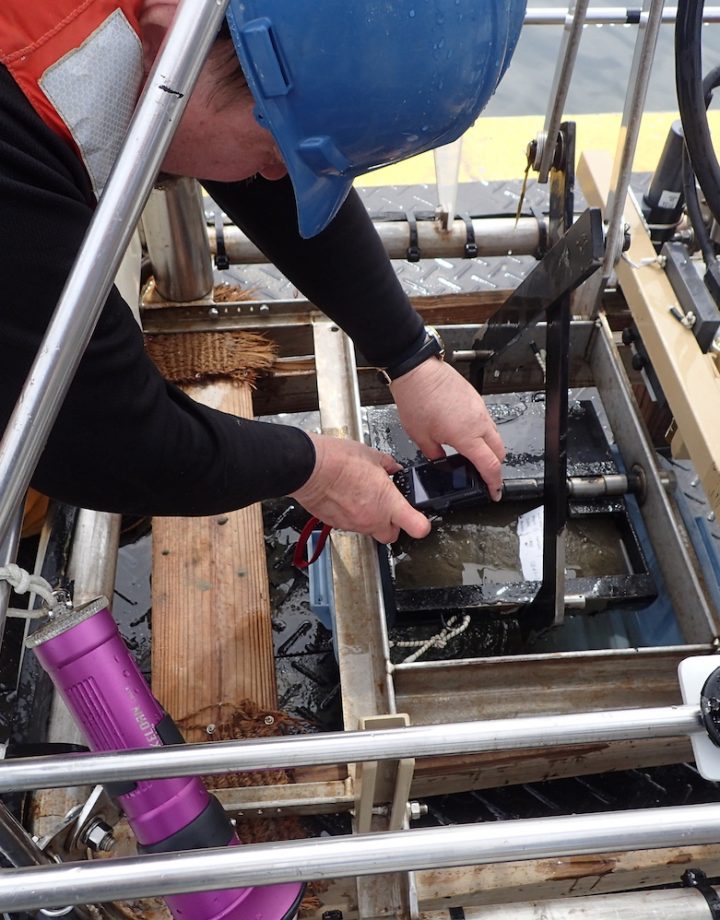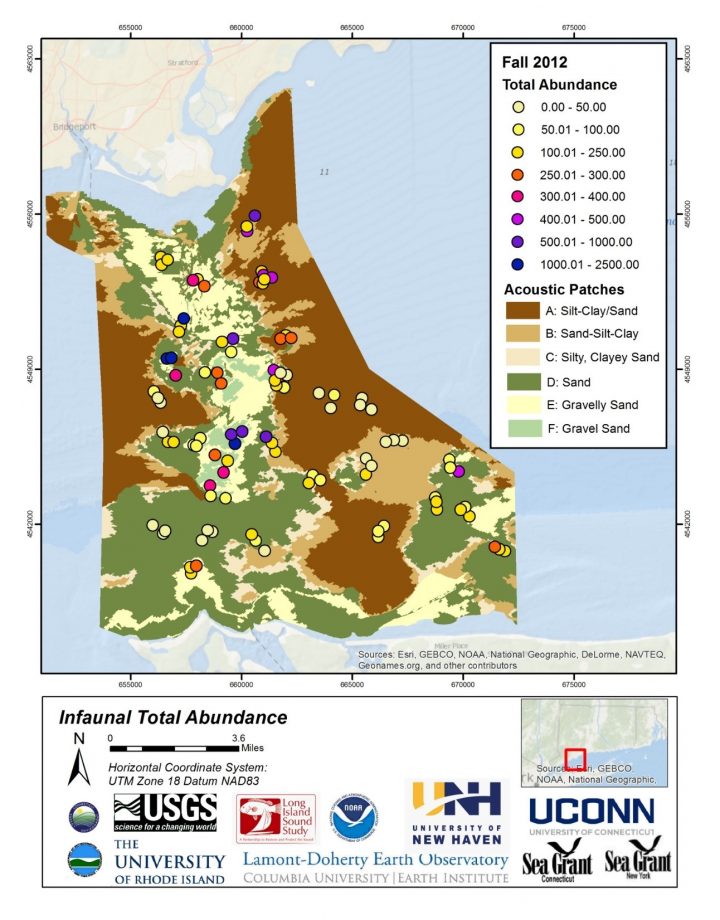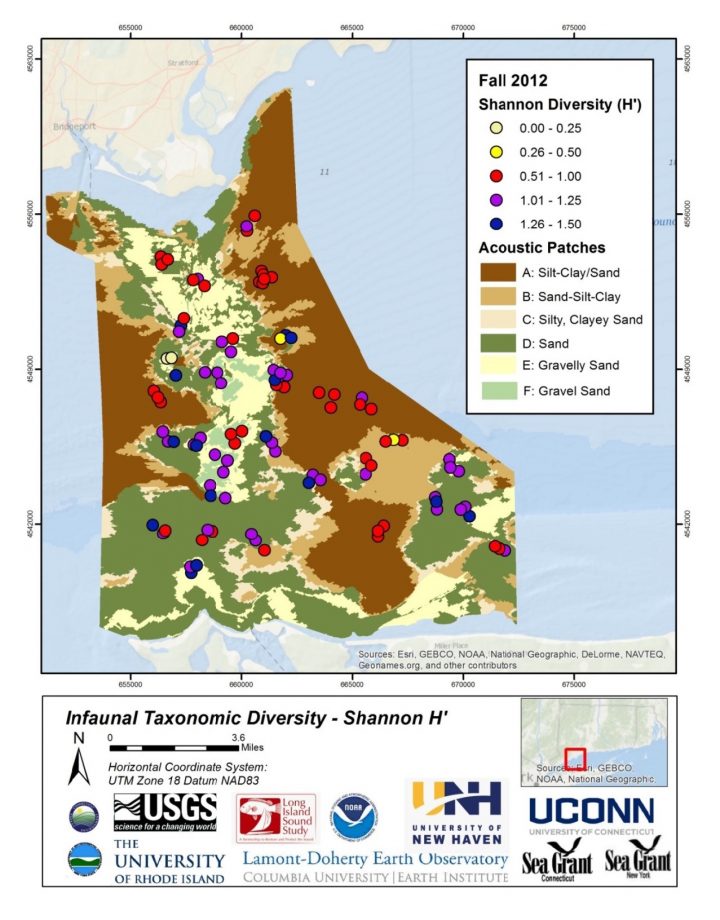The following summarizes the results of the Infaunal Analyses of the Phase I Pilot Area Final Report:
- Infaunal communities were sampled in Fall 2012 and Spring 2013, providing the opportunity to assess temporal variation of infaunal communities in the pilot study area relative to sea floor habitat structure. The sampling efforts differed between research cruises and only a subset of the areas sampled in 2012 were also sampled in 2013.
- A total of 101 grab samples and 60 grab samples (0-2 cm) were processed from the October 2012 and May 2013 research cruises, respectively; that also provided the sediment grain size data. Photos and video collected were also used.
- The characteristics of benthic infaunal communities (abundance, diversity, community composition) were related to the acoustic patch types identified and varied relative to the habitat heterogeneity within and among acoustic patch types. Thus, acoustic mapping and related characterization can provide information on potential general characteristics of the infauna inhabiting the delineated seafloor habitat patches.
- Abundances in patch types with coarser sediments had higher total abundances than patch types with progressively muddier sediments in both Fall and Spring. These patches also had higher total abundances in the spring compared to the fall. Other acoustic patch types had relatively similar mean total abundances among Fall and Spring sampling dates, although seasonal differences in total abundance were spatially variable. Total abundance tended to be highest along the flanks of Stratford Shoal and transitional areas among patch types.
Here are some representative images and data products from this section of the Final Report. Hover your mouse over the image to stop the scroll and see the caption.
- A high number of infaunal taxa/species were found in the pilot study (242 in October 2012, 171 in May 2013). Mean taxonomic richness per 0.1 m2 sample was progressively higher with increasing percentages of sand and gravel in acoustic patch types. This trend was consistent in both Fall and Spring. Seasonal differences within specific patch types were generally not significant, except in the patch type where sediment composition consisted mainly of coarse sands and gravel. Taxonomic richness was general highest on or along the flanks of Stratford Shoal and in the southeast section of the pilot study area in muddy sand and sand acoustic patch types.
- Taxonomic diversity (a combination of both taxonomic richness and the relative abundance of species) was variable among acoustic patch types and also seasonally with specific patch types. Two different diversity measures (Shannon diversity H’ and Fisher’s α) were used to assess the consistency of the patterns. In both cases, within-patch diversity was higher in the fall in patches characterized by sandy sediments, and higher in the spring in patches with either coarse or muddy sediments. The variation in these trends was such that there were few statistical differences in seasonality, but differences among patch types were significant. Infaunal diversity was similar through large portions of the pilot study area, and areas of relatively high diversity found in most acoustic patch types. Thus, the spatial trends in infaunal diversity were complex, with no clear trend that could be associated with general environmental attributes such as depth or sediment type.
- Community structure (taxonomic composition and relative abundances) was relatively distinct among acoustic patches in both Fall and Spring, with differences in the mix of dominant taxa and the relative variation in community structure. Acoustic patch types with predominantly sandy sediments had the most variable communities, whereas communities in patches with muddy or coarse grained sediments were less variable. The most variability on community structure was found in the acoustic patch type that was located in sandy areas in the southern portions of the pilot area and along the flanks of Stratford Shoal. Community structure also varied depending on whether they were located along transition zones among acoustic patch types or located within the interior of a particular patch types. The transition zones appear to have more diverse/complex communities.
- The overall results of the infaunal analyses indicate that these communities and their characteristics can be closely related to the acoustic patch types identified through the habitat characterization analyses. Furthermore, the level of variation in community characteristics and their patterns of spatial and, to a lesser extent, temporal variability have been identified for these various patch types.
- A comparison of data collected from the mid-1990s with the results of the 2012/13 pilot study revealed that there has potentially been a significant increase in the overall diversity of the infaunal communities within a portion of the pilot study area (specifically the northeast and eastern central section where the 1995/6 sampling was done).
The Final Report and Appendixes can be found here: http://longislandsoundstudy.net/research-monitoring/seafloor-mapping



